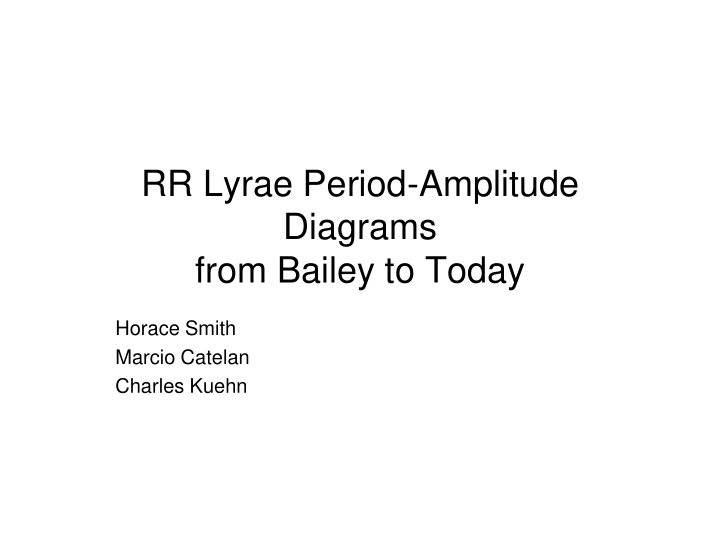



RR Lyrae Period-Amplitude Diagrams from Bailey to Today Horace Smith Marcio Catelan Charles Kuehn
Solon I Bailey
“Cluster variables” in Omega Cen Discovery of the Bailey types (a, b, and c) 1902
Blazhko stars excluded; data from Cacciari et al. 2005; Kaluzny et al. 2004
Shift with Oosterhoff type From Sandage, Katem, & Sandage 1981
Oo II RR Lyrae are brighter than Oo I Sandage 1958
Shift in P-A relation with [Fe/H] implies a shift in absolute mag with [Fe/H] Sandage 1981, 1982 The period-amplitude relation also began to be used for determining [Fe/H] Alcock et al. 2000
But things turn out, as is often the case, to be more complicated
How robust is the P-A versus [Fe/H] relation? Clement & Shelton 1999; Bono et al. (2007)
Applicability of the P-A-[Fe/H] relation Kunder & Chaboyer 2009
Kunder & Chaboyer 2009
M2, M3, and M62 Cluster [Fe/H] HB Type <Pab> M2 -1.62 0.92 0.725 M3 -1.57 0.18 0.555 M62 -1.29 0.55 0.548 HB Type = (B-R)/(B+V+R)
M2 Lee & Carney 1999
M3 Cho et al. 2005
M62 (lots of RR Lyrae) Contreras et al. 2010
Cacciari et al. 2005; Lee & Carney 1999
Contreras et al. 2010
Multiple population clusters and Oo III Cluster [Fe/H] <Pab> HB Type NGC 6388 -0.60 0.676 d -0.69 NGC 6441 -0.53 0.756 d -0.73
Rich et al. 1997; Pritzl et al. 2002,2003; Yoon et al. 2008
Pritzl et al. 2002, 2003
NGC 1466 and Draco Draco Kuehn et al. 2011 Stetson 1980
System <Pab> [Fe/H] NGC 1466 0.59 d -1.8 Draco 0.61 d -1.5 to -3.0
Kuehn et al. 2011
Kinemuchi et al. 2008
Kuehn et al. 2011
A few conclusions 1. Period-amplitude diagrams provide interesting information beyond what period histograms alone provide 2. A single period-amplitude-[Fe/H] relation does not always apply. One can’t always assume a smooth run of [Fe/H] and M v 3. 3. There is a clear period shift in the P-A diagrams between Oo I and Oo II clusters, and the result that Oo II RR Lyrae are brighter than Oo I stands. 4. The metal-rich RR Lyrae in NGC 6388 and NGC 6441 are clearly different from metal-rich field RR Lyrae stars Don’t forget about the RRc period-amplitude diagram, which can 5. reveal some interesting differences among clusters
Recommend
More recommend